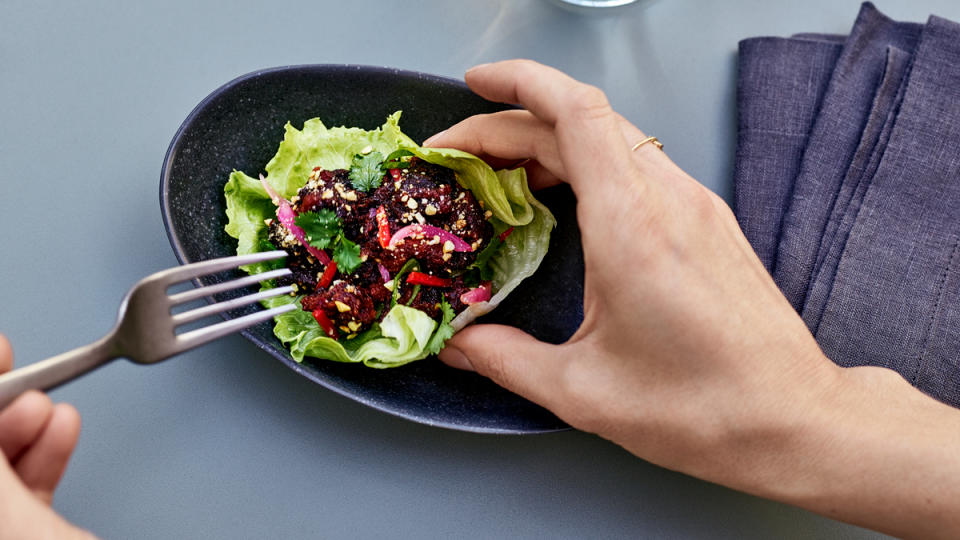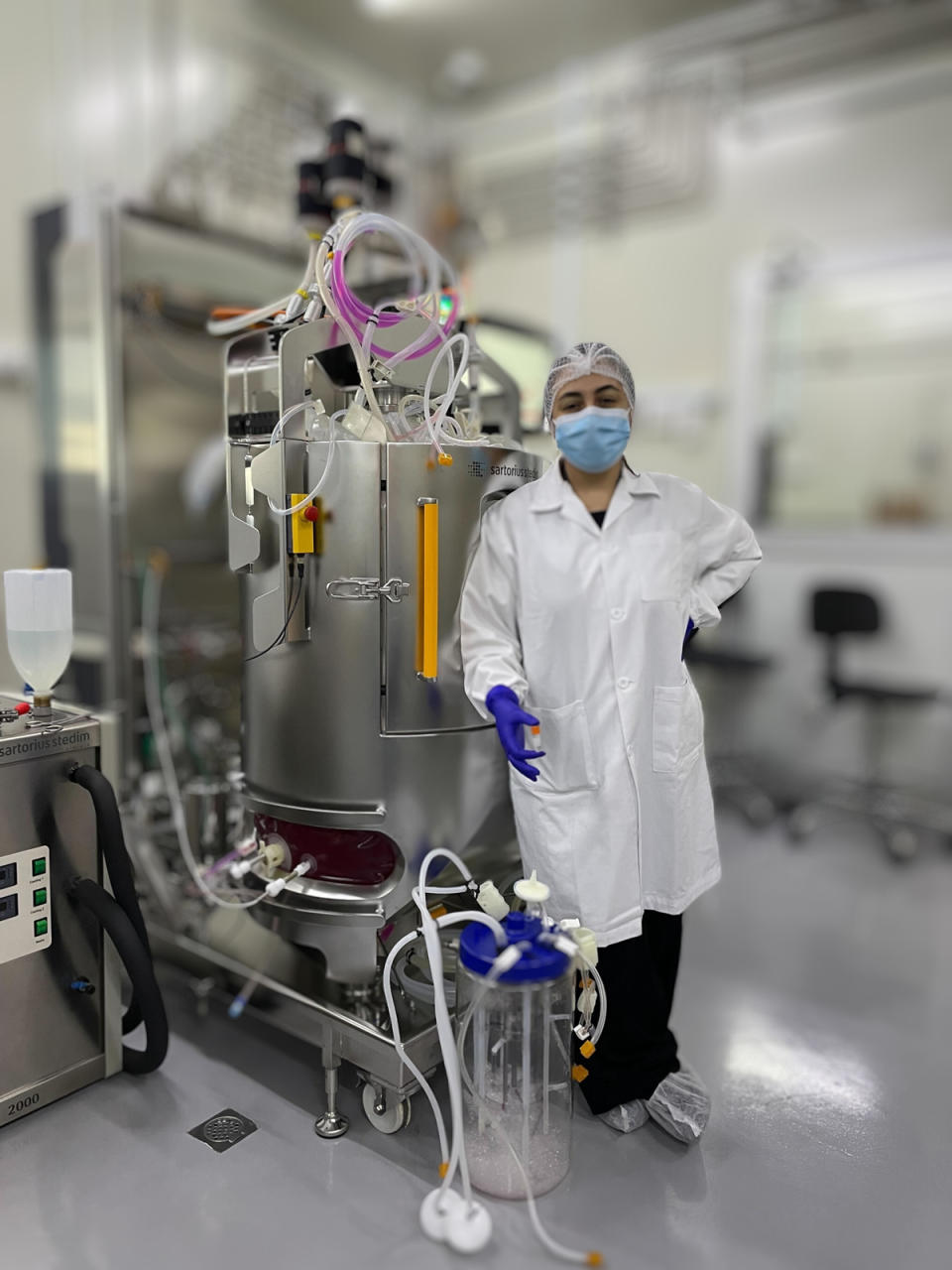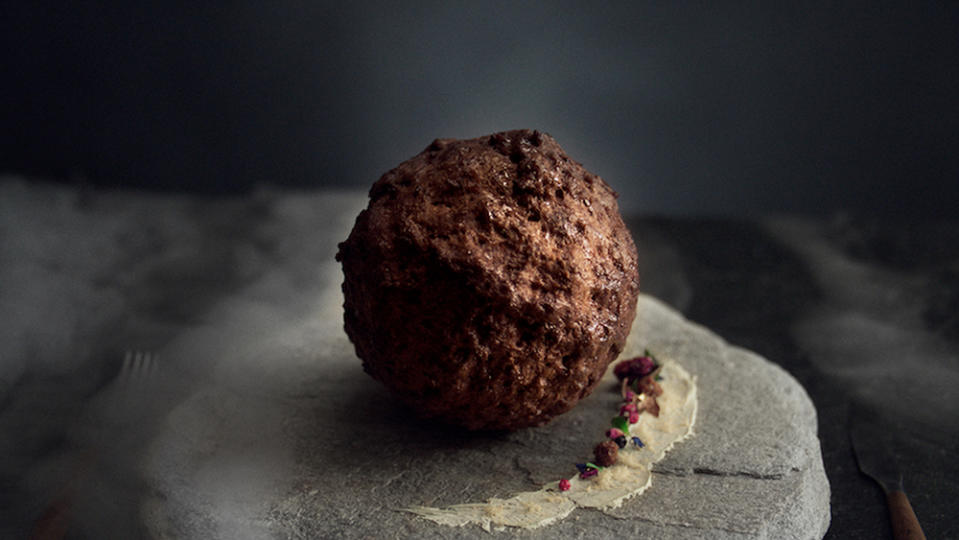How Scientists Keep the World’s Greatest Delicacies From Going ‘Extinct’

San Francisco butcher Guy Crims describes the flavor of Wagyu beef like a fine wine. Like a robust Cabernet or Syrah, there are aromas, top notes, and lingering aftertastes that are unique to Wagyu, the Japanese beef famous for its marbling and intensity. First off, the meat melts almost immediately in the mouth, much like butter. There’s also a distinct sweet, floral and creamy richness to Wagyu, Crims says, while its umami is described as having a “coconutty fruitiness” that travels between the nose and then the mouth. “And the chew is unparalleled with anything else,” adds the head butcher at the Butcher Shop by Niku Steakhouse, the only certified Kobe beef retailer in San Francisco.
A rare and expensive cut of beef with a distinct flavor and texture profile, Wagyu is in a category all its own. But Patricia Bubner is hoping to replicate some of these same characteristics in a lab-grown version of Japanese Wagyu at her San Francisco-based cultivated meat company Orbillion Bio with the help of Crim’s expertise–and without having to send a single animal to the slaughterhouse.
More from Robb Report
Inside the Emergence of Lab-Grown Diamonds and How They Could Shape the Industry
From Vegan Leather to Silence: How Luxury Cars Are Becoming More Eco-Conscious From the Inside Out
French People's Hunger for Frog Legs May Be Leading Some Species to Decline
“We thought that if we’re going to make meat from cells, we want to take the best cells we can get,” Bubner told Robb Report. “Of the beef breeds, Wagyu is on top because of the quality of the meat and its scarcity. And we quickly understood that we can make a product that doesn’t exist in the market right now.”
Wagyu is one of several luxe delicacies that have joined the race to bring lab-grown meat and seafood alternatives to market for reasons that range from environmental, animal welfare, and health concerns. There’s also bluefin tuna and freshwater eel, both overexploited species and expensive ingredients in seafood and sushi restaurants, and foie gras, the controversial French delicacy made by force-feeding ducks that is currently banned in several countries. The state of California has also banned it for resale and in restaurants.
After an optimistic and feverish start, however, the industry has encountered a few setbacks and challenges over the last year. Regulatory obstacles, cost overruns, and longer-than-expected timelines have turned some investors skittish and impatient, drying up venture capital funding and slowing momentum. So far, only the U.S. and Singapore have granted regulatory approval for the sale of cell-cultivated chicken by companies Good Meat and Upside Foods.

But while many companies are simply replicating proteins, premium food companies are trying to distinguish themselves by making rare and scarce foods more accessible, bringing some species back from the edge of extinction, and by using science and technology to make improvements to existing delicacies.
When French entrepreneur Nicolas Morin-Forest founded Gourmey Paris in 2019, the pitch was that its lab-grown foie gras eliminated animal welfare concerns and could help bring the delicacy back to the more than dozen countries where the product is banned. Outbreaks of avian flu have also slashed foie gras production in recent years, jeopardizing the supply chain. But faux and plant-based foie gras already offer consumers an alternative. Morin-Forest knew he needed to step up his game.
“If you follow the simple narrative of, ‘we’re going to do the same product, just differently,’ you’re not going to get a lot of consumers on board,” Morin-Forest told Robb Report. “If you want to escape that niche, you have to think of arguments that resonate more widely.”
For him, that means leveraging the burgeoning science to create a customized product that exceeds market offerings. “We want to be better than conventional foie gras, that’s always been our North Star,” he says.
To achieve this, Gourmey has partnered with fine dining chefs around the world (he declines to identify the chefs for now) to create a “signature” flavor. When pan-seared, the foie gras forms the coveted caramelized crust, while the mouthfeel is rich and velvety. Food scientists also played with woody, earthy, and nutty notes to give the product character.
But what holds particular appeal, is that unlike real foie gras which loses up to 20 percent of its mass when it hits a hot pan, scientists are working on ways to improve the melting ratio so that chefs lose two times less product.

It’s a similar idea at Orbillion, where Bubner says the beef to fat ratio of their Wagyu beef will be customizable according to their client’s wishes, be it chefs or premium food distribution chains. And unlike most minced Wagyu sold in the U.S. today which is American Wagyu (a mix of Wagyu and Black Angus), Bubner says theirs will be 100 percent full-blood Japanese Wagyu, filling a void in the premium meat market.
That said, cultivating Wagyu beef does have its limitations. Instead of steak, the initial launch product will be ground Wagyu, Bubner says, as the technology for creating cell-cultivated meat tissue is still a long way off. “We believe that cultivated meat is not able to produce steaks that are as good as a Wagyu cow,” she says.
Bubner also points out that the technology presents an added opportunity to preserve the cell lines of particularly prized animals, such as single origin Wagyu, or heritage meats like American bison and elk which they recreated in their early days as well. “Just imagine, you could preserve that cell line and enjoy that specific animal over and over again.”
Last year, in a sci-fi-esque development, scientists at cultivated meat company Vow in Australia went a step further and created a meatball from the DNA of a woolly mammoth, resurrecting the ancient animal from extinction. The meatball was not created for consumption, but to represent animals that have disappeared due to planetary warming and showcase how cultured meat can fill the gap (human hunting and the melting of the icebergs are believed to have driven woolly mammoths to extinction).

“What’s amazing about this underlying technology is that you can take any species on the planet, endangered or not, and anything in between, and grow food products from those animal cells,” adds David Kaplan, director of the Tufts University Center for Cellular Agriculture. “That’s not something you could ever do before. This technology is a complete game changer in what it allows you to potentially do.”
Cultivated seafood company Umami Bioworks is also hoping to transform high-end seafood consumption, where there is arguably a greater sense of urgency than foie gras or premium Wagyu beef: Freshwater European eel is listed as critically endangered on the International Union for Conservation of Nature’s (IUCN) red list, and Japanese eel is listed as endangered.
After working for years developing disease management tools for fish and shrimp farms as a biochemist, Mihir Pershad, founder of Singapore-based Umami Bioworks, saw lab-grown eel as a solution to the ongoing problem of critically depleted eel stocks, disease outbreaks at eel farms, and rising consumer demand. In Japan, eel is commonly consumed as kabayaki unagi, where it’s grilled and served in a sweet soy glaze, while smoked eel is a delicacy in European countries like Germany, Poland, the Netherlands, and Sweden.
“The premium segment drives a lot of food trends. And a lot of seafood is both premium and at risk of being extinct in a generation if we don’t find more sustainable ways to produce it,” Pershad says. “And to me that really gives us an opportunity to make a massive difference in the industry.”
At Wandafish, CEO Daphna Heffetz also sees their cultivated bluefin tuna as a solution to unsustainable demand and dwindling supply (the IUCN lists Southern Bluefin Tuna as listed as endangered). But cell-cultivated fish will also be a much healthier alternative to wild-caught bluefin tuna, which is a large predator that lives up to 40 years by feeding off of other fish, building up decades of mercury and other toxins in its body, Heffetz points out. “Bluefin tuna is a very polluted fish,” he says. “Not only does it have all kinds of bacteria and parasites, but it also has a lot of heavy metals like mercury which is very dangerous.”
One of the newer players in the market having launched in 2021, Wandafish is working on producing sushi-grade toro, the fatty underbelly of the bluefin tuna prized in high-end Japanese sushi restaurants. Along with a mercury-free fish, Heffetz said the goal is also to replicate its (pollution-free) nutritional profile and make a product rich in Omega 3 and Omega 6 fatty acids.
What excites Kaplan is the endless potential of cell-cultivated foods, whether it’s pumping beef or fish with added nutrients, customizing the products to desired specifications, or bringing endangered species back from the brink of extinction. But he also emphasizes the underlying raison d’être that is driving the scientific community to make cultivated foods the new reality.
“Whether it’s sustainability, the lack of additional land for growing food, population growth or food security, I hate to say it but in the long run, I don’t think there’s a better alternative. This is the way we’ve got to do it.”
Best of Robb Report
Why a Heritage Turkey Is the Best Thanksgiving Bird—and How to Get One
The 10 Best Wines to Pair With Steak, From Cabernet to Malbec
Sign up for Robb Report's Newsletter. For the latest news, follow us on Facebook, Twitter, and Instagram.

 Yahoo Movies
Yahoo Movies 
